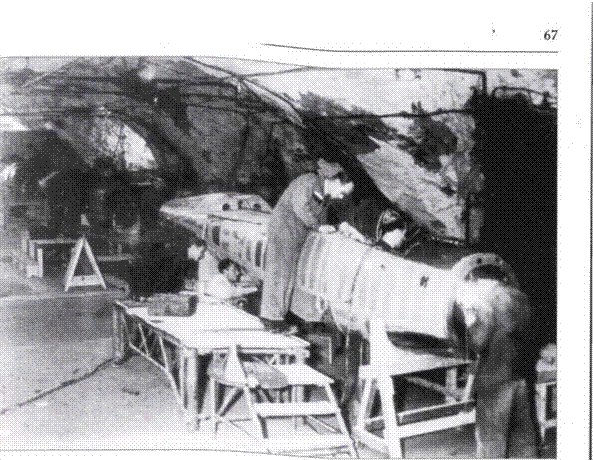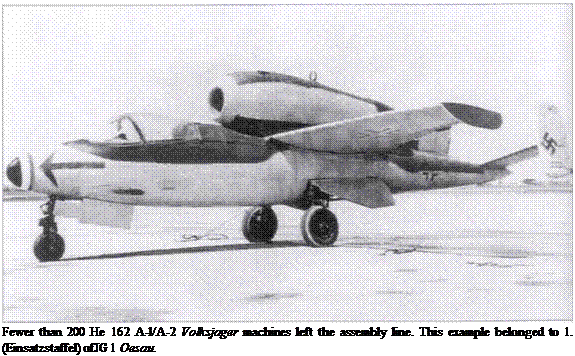At the Last Gasp: Development of the He 162 Spatz
The development of this aircraft dated back earlier than 1944 and 1945. From the summer of 1943 Heinkel had begun to design, in concert with other aircraft manufacturers, a light jet fighter with a single turbine above or below the fuselage. For the mass production of a machine simpler than the Me 262 A-la, the main considerations were the least use of materials and the greatest use of substitutes such as wood and steel plating. This would make production possible in underground factories in enormous numbers at the earliest opportunity.
The Heinkel design office, relocated to Vienna from 1943 under the designation Heinkel-Siid, devoted itself increasingly from the spring of 1944 to this task. By 10 July Project He P 1073 ‘Fast Jet’ had been completed on the drawing board. The machine would have two HeS Oil turbines or failing that Jumo 004Cs. As it was evident to Dr Ernst Heinkel that all He 111 and He 177 production would be stopped, he therefore proposed to Goring the production of a powerful fighter with two HeS Oil turbines. The nimble aircraft would be

armed with three machine guns and make a very difficult opponent. The design was simple to build and the Heinkel development team thought it would be an early success. Time was of the essence. The mock-up was scheduled for completion on 1 October 1944, the first experimental aircraft by 1 December, while mass production could begin simultaneously with the first prototype trials from 1 January.
Heinkels prior work on the design meant that the study was ready within a few days. On 12 July 1944 Obersdeutnant Siegfried Knemeyer of KdE spoke out in its favour and on 8 September the Chief-TLR, Oberst Ulrich Diesing, issued precise guidelines for the T TL-Fighter’, henceforth to be known as the Volksjager. Heinkel-Siid submitted a precise description of the design for the new aircraft which coincided in nearly every respect with the RLM specifications.
The contract was awarded in September 1944 and work commenced ‘with the greatest vigour’. As HeS Oil production at Stuttgart was proceeding haltingly, Chief-TLR decided to fit the original design with the unreliable

BMW 003. The Jumo 004 turbine would have been better, but these were needed more urgently for the Me 262 A. On 15 September Chief-TLR and RLM rejected the design for lack of flying hours of the BMW 003, weak armament and poor operational range. The problems with the BMW turbines were decisive because the engines had already come under scrutiny for their poor reliability. Brushing aside the violent protests of Heinkel director Karl Franke, Chief-TLR now favoured the Blohm & Voss BV P211.01. In the almost daily conferences subsequently, the BV fighter was well promoted, but the Reichsmarschall was provisionally for the Heinkel machine. Shortly after the conference of 21 September 1944 chaired by Roluf Lucht in which progress at Heinkel-Siid was discussed, an improved full-scale mock-up of the He P1073 (designated He 500 from 25 September) was shown to a commission under the chairmanship of Professor Hertel in the presence of Lucht. The pilot would now have far better visibility than in the former version. Except for minor changes in equipment, the Heinkel design had already been cleared at the RLM. The pendulum swung back to the Heinkel design because of aerodynamic problems that had arisen after revisions to the BV P211.02. These were only reservations but came in useful for Heinkel. On 29 September the Jagerstab ordered ‘an immediate start to the Heinkel design. No other competitor awaiting evaluation had a chance.
The Volksjager was not accepted wholeheartedly by General Galland, nor by the Chief of the Luftwaffe General Staff, General Werner Kreipe. Both considered that the Me 262 A-la offered the only possibility of regaining air supremacy over the Reich, even partially. This view was opposed by the Reichsmarschall and Chief of Staff of the Jagerstab, Saur. Wedded to NSDAP ideals, Saur believed that fanatical young pilots of the future Volksjager squadrons would turn the tide of the air war. In view of the losses to be expected and the lack of raw materials, the change-over to easily obtained replacements such as wood or steel plating was also important.
More conferences sought a consensus. The decisions taken to date seemed hasty. Nobody could estimate exacdy when the fighter would be ready for series production, and not until 30 September was the production department in a position to predict that the first mass-production run with the He 162 A-2 could be expected by February 1945. Despite the simplicity of the design, numerous questions and details remained to be resolved, including the installation of the BMW 003 turbine, the form of the wings and tail, the type of undercarriage and the fuel tank unit, all of which were changed again and again to enhance efficiency. There was also in-fighting between Messerschmitt and Heinkel, the former arguing for the monopoly of the Me 262. By October the design had fathered at least 19 different project studies of which the 18 th and 19th were the direct forerunners of the later He 162 A-1.
Requests for modifications continued to arrive from the Chief-TLR, however. After the final inspection of the 1:1 mock-up of the ‘smallest fighter’ by Major Grasser and Fliegerstabsingeneur Rauchensteiner, both with the Galland’s staff, it was agreed that the design work could be rounded off, at least insofar as the first two versions, A-l and A-2, were concerned. The work at Heinkel-Siid would now begin. To make up for the delays staff were putting in up to 100 hours work per week. They slept at their drawing boards and were close to exhaustion. Meanwhile Heinkel had an order for 1,000 He 162s, and this even before a single prototype had flown. To be reasonably sure that the construction would be successful, wind-tunnel trials were undertaken from September 1944 at AVA Gottingen. This was only possible thanks to the great efforts of research engineers. The deadlines for closing reports were very short. This applied also to the final submission of the documentation by 20 October 1944. Nevertheless only 35 per cent of the BMW 003 drawings for the He 162 had been submitted by then. All involved were aware that the BMW 003 was no more than a temporary solution. Though HeS Oil turbines were favoured from the start, work on them was at a standstill and not until March 1945 did the breakthrough come. Unfortunately this coincided with American teams of specialists preparing their own evaluations from the files found in underground storage locations.
By 1 November the project files for the BMW 003-equipped version were completed, and the entire design was to be concluded by 10 December. The optimists reckoned on having the first prototype by 20 January: a second would follow on 1 February. At the end of October 1944 the advent of the Volksjager was announced under the slogan ‘The Fiihrer Fights Back!’ A groundswell of hope surged up. On 30 October the staff at Heinkel-Siid were told: ‘The Heinkel firm will build the aircraft which is to sweep our skies clear of the flying terrorists!’
The infrastructure to achieve such an aim was still lacking. A transport area was prepared, a field railway to Hinterbriihl at Modling (Languste Works) begun and sufficient space made available for a satellite unit of Mauthausen concentration camp near Hinterbriihl, Vienna. Some 2,400 prisoners were to be shipped into the underground Languste facility. This was built on several levels, with the Volksjager metal fuselages to be produced safe from Allied bombing. The SS-WHA (SS Main Office for Industry) played a major role in the project. The wings would be produced at several factories with massive SS support. Human considerations played no role in the underground factories. The limiting factor was the preparation of the necessary raw materials which at that time – unlike forced labour — were only available in limited quantities. The SS had sufficient people, skilled or unskilled, to realise its ambitious plans.
The output rate for Volksjager production was to be increased from 1,000 to 2,000 monthly once several completion shops started up. The SS-FHA (SS Main Office for Management) put SS-Hauptsturmfiihrer Kurt May in charge of resolving all problems relating to obtaining wood and making the wooden parts. Elsewhere the underground Mittelwerk in the Kohnstein mountain (Harz near Nordhausen) was given orders at the beginning of November 1944 to produce another 1,000 He 162 and 2,000 BMW 003 turbines. At first only fuselages were to be turned out, later whole aircraft. Other sections would be produced in large numbers at Heinkel Rostock and Junkers near Stassfurt (Saxony-Anhalt).










